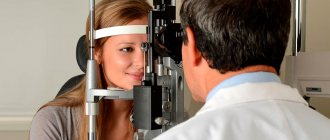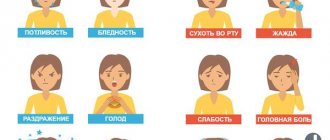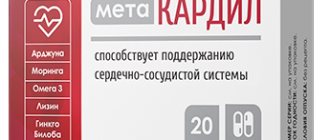A hungry person sometimes experiences a feeling of general malaise, weakness, nausea, and fatigue. After eating, for many this condition disappears.
But for some people, similar symptoms occur precisely after eating. At the same time, the blood pressure level decreases.
This phenomenon in medicine is called postprandial hypotension. But why does blood pressure drop after eating? Determining the cause of low blood pressure in a hypertensive patient or a healthy person is impossible without a diagnostic examination, including blood pressure measurements, blood and urine tests, and collection of medical history.
Clinical manifestations
Why does blood pressure drop after breakfast or any other meal? Postprandial hypotension in English means “lunchtime”. This means that blood pressure levels tend to drop after consuming foods. In patients suffering from this disease, the decrease in pressure is, on average, 20 mmHg.
The clinical manifestations of the disease are easily confused with the symptoms of ordinary hypotension. Patients experience:
- heart rhythm disturbances;
- feeling tired and drowsy;
- excessive sweating;
- dizziness and headaches;
- speech and vision disorders;
- pain in the sternum and heart;
- apathetic state characterized by lethargy;
- fainting after a meal.
Patients begin to feel unwell immediately after consuming foods or drinks. Added to the above problems are nausea, leading to vomiting, as well as black dots flashing before the eyes.
Symptoms of postprandial hypotension can occur even in patients suffering from arterial hypertension.
Prerequisites for the disease
It is impossible to unequivocally answer the question of why blood pressure drops after eating.
There are some factors that contribute to changes in pressure:
- elderly age. Patients over 65 years of age are susceptible to the disease due to age-related changes occurring in the body;
- organic brain lesions, including Alzheimer's disease and Parkinson's disease;
- mental illnesses, including neurasthenia, psychopathy, neuroses;
- endocrine diseases.
Patients who regularly attend hemodialysis and patients with chronic kidney disease are at risk of developing this disease.
Diagnostics
Since the symptoms of postprandial hypotension are similar to arterial hypotension, it is impossible to rely only on blood pressure measurements when making a diagnosis.
Blood pressure monitoring should be carried out over several weeks, and its values should be recorded while taking medications, during specific activities and during sleep.
Specific activities include eating, physical activity, and standing. Also, to diagnose the disease, special testing is carried out to detect transient arterial hypotension. Hypotension may be a symptom of renal dysfunction, neurogenic fainting, and other diseases.
Diagnostic measures must be carried out in order to establish the cause of a drop in blood pressure in hypertensive patients or a healthy person, and to identify physiological or pathological disorders. So, if there is a sharp drop in blood pressure, the cause for a hypertensive patient may be an overdose of antihypertensive drugs.
To begin with, the doctor collects anamnesis, listening to the patient’s complaints. Then he prescribes examinations to confirm or exclude heart disease, infectious diseases, anemia, and disorders of the endocrine system.
A urine test is performed to determine sodium and potassium levels. This will reveal whether the patient suffers from adrenal insufficiency or not.
If, a couple of hours after eating, the pressure regularly decreased by at least 20 mmHg throughout the monitoring, or if the pressure remains at the same level, but the patient shows signs of a hypotonic state, then this may indicate the presence of postprandial hypotension. The doctor makes the final diagnosis after comparing pressure measurements and diagnostic test data.
Postprandial hypotension affects the body in a complex manner, which means that to eliminate the problem, you should undergo examination by specialists in various fields: cardiologist, gastroenterologist, neurologist, nephrologist, endocrinologist.
Diagnosis of hypoglycemia
The signs of this condition are quite characteristic, and the primary diagnosis is most likely made after a conversation with the patient and his examination.
The only difficulty is finding out the true cause of this pathology. Therefore, a wide range of laboratory and instrumental examination methods are used for diagnosis. First of all, if hypoglycemia is suspected, a blood test is performed to check the sugar level, which in this condition drops below 3.5 mmol/l. This test may produce biased results because many factors, including time of day, affect sugar concentrations.
The determination of glycosylated hemoglobin (HBA1c) is of great diagnostic importance. This is a stable combination of hemoglobin A with glucose in red blood cells: the more glucose in the blood, the higher the level of HBA1c. Throughout the life of a red blood cell (120 days), this compound continues to circulate in the blood, and determining the concentration of HBA1c allows us to reveal the true concentration of glucose over the last two to three months.
In order to establish the cause of hypoglycemia, a blood test is performed for hormones (in particular, the thyroid gland and adrenal glands), the presence of excess alcohol and medications, a urine test, a biopsy of the liver and pancreas to confirm insufficient production of enzymes, ultrasound, MRI and CT scan of internal organs.
Treatment
Treatment of the disease includes changing dietary habits and a healthy lifestyle. If necessary, the doctor prescribes drug therapy.
Since a decrease in pressure occurs after eating, the main recommendations are related to food consumption:
- spices should be consumed within reasonable limits;
- it is necessary to reduce the amount of quickly digestible carbohydrates in the diet;
- overeating should not be allowed;
- You should not fast for a long time.
If a sign is detected that a product leads to a decrease in blood pressure, it should be excluded from the menu. You need to avoid stressful situations, strengthen your immune system and include physical activity in your daily routine.
Causes of hypoglycemia
A decrease in blood sugar levels is not a disease, but a condition that occurs due to a number of disorders of carbohydrate metabolism in the body.
Glucose, as a source of energy, determines the functioning of internal organs and the condition of a person as a whole. The brain is especially sensitive to a drop in sugar concentration. It works more intensively than all other organs, consumes an increased amount of “fuel”, is not able to store it and therefore is completely dependent on the continuous supply of glucose through the bloodstream.
In the body of a healthy person, excess glucose from carbohydrates received from food is stored in the liver in the form of glycogen - a molecule consisting of many interconnected glucose molecules, which, if necessary, is broken down and absorbed into the blood. This ensures the smooth functioning of organs. Thus, any liver pathology can lead to hypoglycemia.
In addition, hormones significantly influence glucose metabolism:
- pancreas: insulin (responsible for the accumulation of glucose in the form of glycogen and reducing its level in the blood) and glucagon (stimulates the breakdown of glycogen, which causes an increase in sugar levels);
- adrenal glands: adrenaline, cortisol, growth hormone (increases sugar);
- thyroid gland: thyroxine and triiodothyronine (increase sugar).
Hypoglycemia is most often observed in diabetes mellitus.
On the one hand, the patient takes glucose-lowering medications. On the other hand, glucose from the liver enters the blood slowly. This leads to the fact that at some point the sugar concentration may drop to critically low values. This condition also occurs as a result of diseases of the gastrointestinal tract with impaired absorption of glucose, renal failure (increased excretion of sugar in the urine), cancer of the pancreas and some congenital pathologies.
Hypoglycemia resulting from disease is called pathological. In contrast, physiological hypoglycemia develops in healthy people during fasting, dehydration, emotional stress or excessive physical activity, taking certain drugs and alcohol.
In women, hypoglycemia is sometimes observed during pregnancy due to the fact that part of the mother's glucose is spent on fetal development. Hypoglycemia in children develops in the first hours or days after birth and can be temporary or permanent. Risk factors include prematurity, maternal diabetes, birth asphyxia, and congenital pancreatic anomalies.
How to properly plan a diet?
There is no special diet for arterial hypotension, just as there are no restrictions on the intake of foods or methods of cooking them. But no one has canceled the rules of healthy eating when there is a decrease in blood pressure after eating. You should absolutely not get carried away with diets, including newfangled ones, such as a raw food diet and blood type diets.
Nutrition for hypotension should be healthy, without dietary restrictions, and must include:
- a large number of green vegetables;
- grains and legumes;
- high-quality fats, sea fish, eggs, chicken meat;
- dairy products from goat milk;
- various fruits;
- not roasted nuts and seeds.
Any hydrogenated fats, synthetic additives, and especially sugar substitutes for hypotension are categorically excluded. A patient suffering from low blood pressure should definitely drink plenty of fluids.
For headaches and general weakness, a quick but short-term effect is provided by strong tea and coffee, cocoa, dark chocolate.
After some time, cheerfulness will be replaced by apathy. The substances contained in these products deplete the body, returning strength for a while, and then increasing fatigue and weakness.
For hypotension, it makes sense to pay special attention to spices, especially hot ones: cayenne pepper, chili pepper. You can use cinnamon in small quantities. Soy is not recommended for low blood pressure. Symptoms of postprandial hypotension are significantly reduced by drinking 0.5 liters of warm water, about 22 degrees.
For postprandial hypotension, fasting is prohibited! Even short-term fasting can lead to secondary arterial hypotension in patients who had normal blood pressure.
Video on the topic
The main reasons for low blood pressure in humans:
If after eating your blood pressure regularly drops by at least 20 mmHg, this may be a manifestation of postprandial hypotension. The clinical picture of the disease is similar to the signs of arterial hypotension and manifests itself in general malaise, increased heart rate, drowsiness and apathy after eating, excessive sweating, chest and heart pain, speech and vision disturbances, and sometimes fainting.
If blood pressure drops after eating, the causes can only be identified through long-term blood pressure monitoring and a series of diagnostic tests. The main treatment is aimed at changing lifestyle and diet. Patients' meals should be fractional. You should avoid taking carbohydrate foods. Coffee, tea, and spices are allowed. You need to drink enough water and avoid drinks with high sugar content. Therapeutic exercises and giving up bad habits will also contribute to recovery.
The information on the MyMedNews.ru website is for reference and general information, collected from publicly available sources and cannot serve as a basis for making a decision on the use of medications in the course of treatment.
MyMedNews.ru
And we also have
Obesity causes changes in brain structure
Symptoms and types of hypoglycemia
Hypoglycemia is characterized by various symptoms, the nature and severity of which depend on the individual patient and the cause of the pathology.
The main signs of this condition include obsessive hunger, increased sweating, nausea and vomiting, weakness, tremors in the limbs, rapid heartbeat, decreased concentration, drowsiness, visual disturbances (blurred vision, double vision and “gnats” in the eyes), panic and anxiety, paleness of the face.
There are three types of hypoglycemia based on severity:
- Mild (a person is able to independently help himself by consuming sweet drinks and sugar-containing foods).
- Moderate severity (the person remains conscious, but needs the help of third parties to normalize blood sugar levels).
- Severe (a hypoglycemic coma occurs, the person is unconscious and needs urgent hospitalization).










